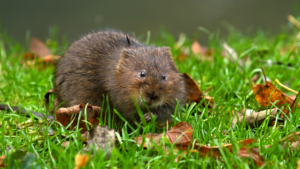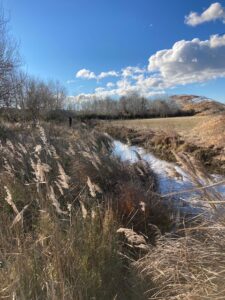The southern water vole: study of an endangered species in the Vallée des Baux

©suerob
The “cousin” of the land vole, better known in our countryside, the southern (or southwestern) water vole (Arvicola sapidus) is less invasive and much more discreet. As its name suggests, the water vole has a lifestyle entirely associated with water, living on the banks of streams, rivers, ponds and in various wetlands. Endemic to France and the Iberian Peninsula, it is one of the few rodent species threatened with extinction and protected at a national level. Our team recently conducted a large-scale survey to learn more about its distribution in the valley.
The “Trame Turquoise” (Turquoise Framework): our study area
 Knowledge of the southern water vole is very fragmentary, even though major field surveys took place in France between 2010 and 2013 as part of a national survey coordinated by the SFEPM (French Society for the Study and Protection of Mammals). An initial search for the species by our teams in 2018 in the Baux valley yielded some presence data.
Knowledge of the southern water vole is very fragmentary, even though major field surveys took place in France between 2010 and 2013 as part of a national survey coordinated by the SFEPM (French Society for the Study and Protection of Mammals). An initial search for the species by our teams in 2018 in the Baux valley yielded some presence data.
In 2021, the Alpilles Regional Nature Park asked us to map the “Turquoise Framework” of the Baux marshes. Some species in the valley have a life cycle that depends on both wet aquatic environments (blue framework) and drier terrestrial environments (green framework), such as amphibians, dragonflies, birds and certain mammals such as the southern water vole. This buffer zone is called the “Turquoise Framework” and is the subject of restoration projects aimed at combating the loss of biodiversity.
As the southern water vole is a typical species of this framework, a team of volunteers led by our civic service volunteer Jeanne Forcade, a graduate in ecology, started a large-scale study in November 2021 in order to better understand its distribution on the 3,000 hectares of the Vallée des Baux and to map it.
A meticulous survey
 In concrete terms, the survey method consisted of dividing the entire study area into 1 km squares. Within each square, at least two routes were determined, located along the banks of canals or roubines (small drainage canals or canals used for irrigation), situated in environments that are most favourable to the species. These routes were carefully prospected to find signs of the vole’s presence: droppings, refectories (sites where small piles of cut stems are found) or even tracks laid out in the tall grass (sort of tunnels that regularly lead to new signs).
In concrete terms, the survey method consisted of dividing the entire study area into 1 km squares. Within each square, at least two routes were determined, located along the banks of canals or roubines (small drainage canals or canals used for irrigation), situated in environments that are most favourable to the species. These routes were carefully prospected to find signs of the vole’s presence: droppings, refectories (sites where small piles of cut stems are found) or even tracks laid out in the tall grass (sort of tunnels that regularly lead to new signs).
A strong presence
By the end of February 2022, Jeanne and her team had surveyed 32 squares, covering most of the Vallée des Baux. The presence of the southern water vole was confirmed in 13 squares and suspected in 4 others. These initial results show that this threatened mammal benefits from a favourable environment locally and allows us to better understand its distribution.
The sectors where the southern water vole has not been observed could also be the subject of protection measures, such as the sustainable management of the banks of canals. In the coming months, as part of the more global study on the Turquoise Framework, we will provide the Alpilles Regional Nature Park with precise recommendations to help safeguard the species.
